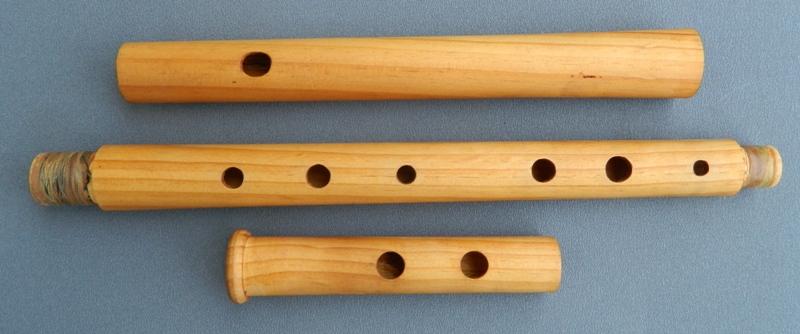The article
John Coltman,
Baltimore flute researcher published the result of an
experiment in Scientific American which is often touted as
being the last word on this topic. Unfortunately it isn't,
and for easily understandable reasons.
John's experiment
involved (from memory) three flutes made of three different
materials, the most outlandish being concrete. I seem to
remember that only the bodies differed, but I can't be sure,
and it doesn't really impact on our findings. Essentially,
an assembled audience was unable to tell the difference
between the sound of the three flutes. The conclusion
reached is that materials a flute is made of makes no
difference.
There is good
scientific basis for John's findings - the performance of a
flute is going to be principally determined by its shape -
the shape of the bore, the shape of the embouchure hole, the
shape of the finger holes. The moving parts of a flute are
air molecules, and the flute itself is simply the container
for the vibrating air column. Providing it's a satisfactory
container - it's smooth, it doesn't leak and it's strong
enough not to vibrate and rob energy from the vibrating air
column. John's three materials adequately met those
criteria.
But supposing your
container wasn't so perfect. To test the difference timber
can make, I made a flute from our local plantation timber -
pinus radiata - a coarse, soft, porous timber used for
building framing. It leaked so badly at first I couldn't
play a note below A, and even those notes were weak and
noisy. So there's a major difference immediately! With the
typical 4mm walls of a wooden flute, I could suck air right
through the walls! Once heavily oiled (ie we plugged the
leakage), it would play down to the bottom notes, but not
with great enthusiasm. I could feel the body of the
instrument vibrating, and that energy has to come from
somewhere.
So who's right, John
or me? Answer, both of us, because we're looking at
slightly different questions. John was probably aiming his
experiment at the metal flute market, particularly those who
spend vast amounts of money on flutes of exotic metals. It
probably didn't occur to him to consider using materials
that were inadequate containers. Why would you do that?
But inadequate
containers is wooden flute business. No wood is perfectly
smooth, perfectly airtight and infinitely strong, although
most of our flute timbers are adequately smooth, airtight
and strong for our purposes. That's why they are called
flute timbers! But my experiment shows that it is a
spectrum, and that a timber not at the far end can be
expected to give slightly different results to a timber at
the far end. Boxwood would be such a timber - about 80% of
the density of timbers in the african blackwood category.
Coming back a little more, the "fine furniture timbers" -
rosewoods, walnut, etc are half the density or less, and a
good deal coarser in the grain - we should certainly expect
less of them. And that's why they are not normally used for
flute-making.
Should we expect
listeners to be able to tell the difference between
rosewood, boxwood and blackwood? Probably not. In my
experience listeners listen to the music and the musician,
not the instrument, unless it is very bad indeed. Was it
the violinist Yehudi Menuen who, more than a bit cheezed off
with the public attention given to his Stradivarius, came on
stage, played to rapturous applause and then shocked his
audience by smashing the fiddle, which turned out to be a
cheap student model.
I would expect an
experienced (and blindfolded) player to notice some
differences in the performance of similar flutes made from
radically different timbers, and to be capable of consistent
and meaningful discernment.

The Pine Prattens.
As you can see, I didn't go to too much trouble - no
rings, cap, corked tenons, etc. But it is faithful to
the dimensions I normally use for my Pratten's model. |